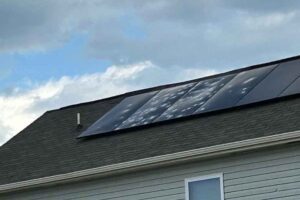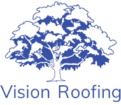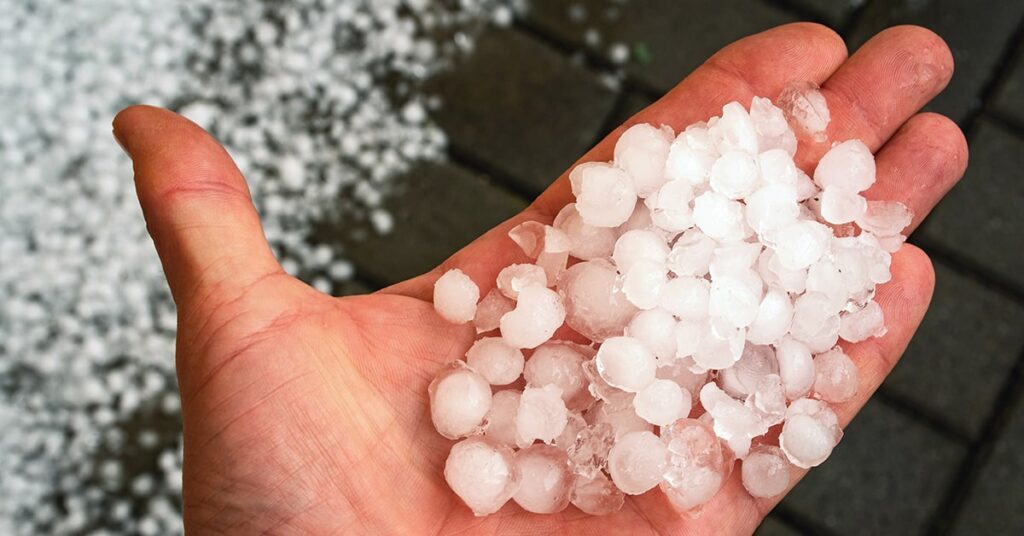Hailstorms can be easily overlooked. Though they may feel similar to rain or snowstorms, the more forceful impact of hailstones can leave real and lasting damage to your property — especially the roof.
Hail damage is extremely common in some parts of the U.S. and can lead to a significant amount of damage that can result in a roof replacement. It’s crucial to know what to look out for when considering if a recent hailstorm caused damage to your roof. Any damage should be noted and addressed immediately, as damage left over time can lead to more significant issues with your roof, such as leaking.
Let’s look into ways to prevent hail damage before the storm, signs of damage that you should keep an eye out for, and what to do if you’ve identified clear signs of damage to your roof.
Jump Ahead
- Signs of Hail Damage From the Ground
- Signs of Hail Damage From the Roof
- Different Roof Materials and Hail Damage
- When Does Hail Damage Occur?
- Preventing Hail Damage to Your Roof
- How to Handle Hail Damage to Your Roof
- Hail Damage Roof Insurance Claims
Signs of Hail Damage From the Ground
Damage to your property and your roof should be inspected both from the ground and directly on the roof. Signs of damage caused by hail that can be identified from the ground include:
- Damage to your fence, shutters, or mailbox
- Pieces of plant debris or your roof on the ground
- Holes in window screens
- Plants on your property left without leaves after the storm
- Dents in your cars, garage doors, or air conditioning unit
- Dented or dislodged gutters, gutter screens, or downspouts
- Damage to house siding, flashing, windowsills
- Dings and dents to the exterior of your garage door
- Cracked or broken windows
- Dents on your electric meter
If any of these signs are identified, there may be resulting damage to the surface of your roof. Though these signs alone don’t guarantee damage has occurred, it’s a good sign that you should take a closer look at your roof’s surface to determine if you will need to take any action.
One thing to look out for is if the damage to your property and your roof is cosmetic, meaning it only affected the damaged materials on the surface, or functional, which entails deeper and more problematic damage that may cause future issues.
An example of functional damage includes deep divots or punctures in roof materials that may lead to leaks. The level of inspection needed to identify these subtle differences can be difficult without taking a closer look at the roof itself.
Signs of Hail Damage From the Roof
Once you’ve decided that further inspection is necessary to see the extent of the damage to the roof materials, it may be time to call a roofing professional who specializes in storm damage.
Though it may be tempting to climb onto your roof, it’s not a safe option for most people – depending on your roof layout, age, and experience level.
Once on your roof, a professional will look for signs of damage that depend on its material, such as:
- General: Dents or chipped surfaces on vents, chimneys, or skylights
- For Asphalt or Soft Tile: Damaged shingles with oval divots, round black dents, cracks, or shingles that are missing entirely
- For Slate or Ceramic: Sharp-edged holes, punctures, and cracks, shattered or cracked tiles
- For Metal: Scratches called “scour marks” that may occur if the roof is hit by hailstones at an angle, dents on the metal surface
Charlotte roofing contractors will be able to tell if the damage is cosmetic or functional, and will be on the lookout for any hidden damage from the hail.
Hidden damage can occur when hail strikes a shingle in a way that causes damage to the backside of the material, making it difficult to tell that it’s damaged by just looking at the surface. Many roof experts will be able to lift and inspect shingles that they suspect have this type of damage and properly reseal them after.
It can be challenging to discover where hail damage has occurred on your roof if you don’t know where to look. You may notice several impressions that have formed on the asphalt shingles if the hail was more than one inch in size. If you notice a lot of dimples that are present, it indicates the rest of your roof is likely damaged.
Different Roof Materials and Hail Damage
Not all roofing materials are impacted in the same way when they have contact with hail:
- Asphalt Shingles (Class 3 or 4): One of the most common roofing materials with a reputation for withstanding the impact of hail
- Metal Panels: Known to be resistant and recommended in climates where hail is common. Even the largest hail has difficulty penetrating metal roofs, contributing to their lifespan of 40 to 70 years
- Cedar Shingles and Shakes: Less likely to suffer from hail damage due to their durability. This type of roofing material has a high UL2218 rating
- Slate Panels: Their density prevents hail from damaging the tiles easily, allowing slate tiles to last an average of 150 years before they begin to deteriorate
- Clay and Concrete Tiles: More likely to develop small and large fractures after hail has contact with the materials. The tiles can also break easily due to foot traffic
- Asphalt Shingles (Class 1 or 2): At a higher risk of suffering from damage because they have less durability with their construction, which can quickly lead to leaks if the necessary repairs aren’t performed
Checking the hail-resistant rating of each roofing material can make it easier to determine if your roof will hold up well in the middle of a heavy storm.

When Does Hail Damage Occur?
The most common time of the year when hail damage occurs is between March and October when storms are present. Hail can still occur at different times of the year, especially if the weather patterns shift.
Hail develops when the freezing altitude of the air drops below 11,000 feet, which is common in the Midwest. The hailstorms begin to form when different layers of water begin to attach to each other in a large cloud. Frozen droplets start to be released from the cloud but can push back up due to the wind that is present.
Preventing Hail Damage to Your Roof
There are several ways you can prepare your property to make your best attempt at preventing any type of damage so you can avoid the expense and hassle of hiring a roofing pro.
1. Choose the Right Building Materials
If you are replacing your roof or are in the process of building a home from scratch, you have the opportunity to choose the materials that will go into making your home safer from the elements.
While it can be more expensive, using more durable materials can lessen the threat of damage from hailstorms and increase the life of your roof. You should be careful when choosing roofing materials, as each choice has its benefits and drawbacks.
For example, asphalt and slate can both be considered durable materials that hold up well to storms. However, it’s important to know that asphalt shingles can be repaired easily while slate tiles require professional help, as they are heavy and easily damaged.
Because of these differences, you must do research to determine which roof material will best suit your needs not only for durability but also for your budget and ability to maintain it.
2. Build Natural Barriers
Hail damage to your property is often prompted by strong winds blowing the hail stones forcefully in your direction. One way to mitigate this effect is by taking preventative measures to lessen the strength of these winds – stopping the hail at its source.
By installing intentional barriers strategically around your home, you can easily break the path of wind and hail. Examples of these barriers can include:
- Trees
- Fences
- High walls
Though building these may cause extra strain on your budget and time, these barriers have other benefits as well. Planting trees supports the environment and walls and fences add security to you and your family.
3. Perform Regular Inspections
Regular inspections can help you ensure that your roof is holding up over time, giving you peace of mind that your home is safe to live in despite all it goes through.
These inspections also offer value through the record-keeping that takes place. By documenting the exact condition of your roof regularly, you may have more success in the future if you need to file an insurance claim and they assess the condition of your home before and after a hail storm or other natural event takes place.
How to Handle Hail Damage to Your Roof
If your preparation to protect your home falls through and you or a professional notice functional signs of hail damage that threaten you or your property’s security such as holes, cracks, or leaks – it may be time to start the process of repair.
It’s important to address any of these as quickly as possible to keep your home safe. Even smaller issues may become larger over time, and should not go overlooked. If you have personal experience in construction, repair, or roofing, it may be an option to repair the roof yourself to save costs.
In most cases, a professional roofer is the best way to get an idea of what is wrong and get it fixed promptly.
Depending on the level of damage, it may be time to file an insurance claim so they can cover the costs of repair.
If the damage is extensive or you’re feeling unsafe with your current roof, another option is to consider Charlotte roof replacement. Rebuilding a roof with new, more durable materials will help ensure that the safety of you and your Charlotte home is intact.
Hail Damage Roof Insurance Claims
If a roofer discovers damage on your roof that requires repairs, you’ll need to start the process of filing a claim with your homeowner’s insurance provider. Many homeowner’s insurance companies require a professional to perform an assessment to confirm if repairs are needed before they process the claim.
Filing a hail damage roof insurance claim requires submitting the dates of the damage. Although most companies give you up to a year to file a claim, it’s important to file it as soon as possible to avoid complications or delays. An insurance adjuster will visit the property and will also request that you receive a quote from a reputable roofing company in the local area.
After the claim is approved, you can move forward with the necessary repairs and will receive the initial payment for the repairs or roof replacement. Once the work is completed your contractor will notify the insurance company and the final claim payment will be released. Expect to pay your deductible and any additional work you may want done at the time.
Next Steps:
- If the hail damage is extensive, learn how to navigate roof replacement insurance claims
- If your roof requires repair, get a customized quote by contacting Vision Roofing
Every storm damage assessment from Vision Roofing is done by a licensed professional with experience in the insurance industry, so you get context around not just the damage, but what will likely be covered as well. Contact us online or by calling 704-312-8558 to schedule your hail damage inspection.


